
Elephas Maximus 2005
Distributed by Canisius Ambassadors for ConservationCanisius College, 2001 Main Street, Buffalo, NY 14208; 716-888-2518; email: cac@canisius.edu
Produced by Michael Noonan
Directed by Michael Noonan
DVD, color, 32 min.
Jr. High - Adult
Animal Behavior, Environmental Studies
Date Entered: 01/19/2011
Reviewed by Cliff Glaviano, formerly with Bowling Green State University Libraries, Bowling Green, OHThis video presents the history, conservation ecology and behavior of Elephas maximus, the Indian elephant. Host Lindsay Schamel, assisted by graphics, provides an overview of the evolutionary tree of the elephant, including the differences between African and Indian elephants. The history of the Indian elephant, its habitat, and threats to its continuation as a species are explained. The chief threats are competition with humans for habitat (human population has risen from millions to billions on the Indian subcontinent and loss of habitat has decreased the numbers of the Indian elephant from about half a million to about 40,000 currently) and depletion from poaching to feed the ivory trade, some 100,000 in the past century.
The particular problems of conserving the population of Indian elephants, which require large land sanctuaries to allow them to maintain their unique matriarchal family structure, becomes extremely complicated as Elephas maximus, unlike other large mammals, is rarely successfully bred in captivity.
This is a very informative, very professional video. Though the Canisius Ambassadors for Conservation (CAC) received support from Sri Lanka’s Pinnewala Elephant Orphanage, several upstate New York zoos (Buffalo Zoological Gardens, Seneca Park Zoo, Rosamond Gifford Zoo), the Buffalo Museum of Science and the Oishei Foundation, the final product appears to be the collaborative effort of the CAC and writer/producer/director Dr. Michael Noonan. Much of the video was captured on location in Sri Lanka or at the Buffalo Zoo by videographer Erik Michaelsen, and edited seamlessly by Nathan Johnson into this concise, appealing documentary.
Educators, tell your colleagues! This excellent video is available free (DVD or digital download from the CAC website) and is
Awards